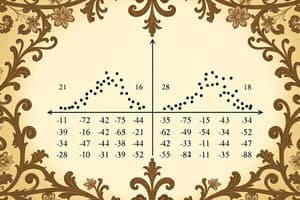Podcast
Questions and Answers
What is the covariance of a bivariate statistical series of variables X and Y denoted by?
What is the covariance of a bivariate statistical series of variables X and Y denoted by?
- σX or Cov(X,Y)
- Cov(X,Y) or σXY (correct)
- ρ(X,Y) or σXY
- σXY or ρ(X,Y)
What is the correlation coefficient defined as?
What is the correlation coefficient defined as?
- Cov(X,Y) - (σX * σY)
- Cov(X,Y) / (σX * σY) (correct)
- Cov(X,Y) / (σX + σY)
- Cov(X,Y) * (σX * σY)
What is the range of the correlation coefficient?
What is the range of the correlation coefficient?
- 0 to 10
- 0 to 1
- -1 to 1 (correct)
- -10 to 10
What is the purpose of the correlation coefficient?
What is the purpose of the correlation coefficient?
What is the covariance of X with itself equal to?
What is the covariance of X with itself equal to?
What is the formula for the covariance of the bivariate statistical series of variables X and Y?
What is the formula for the covariance of the bivariate statistical series of variables X and Y?
What is the primary focus of this chapter in statistics?
What is the primary focus of this chapter in statistics?
What is the outcome of computing covariance and correlation coefficient?
What is the outcome of computing covariance and correlation coefficient?
What is the purpose of the scatter plot in statistical analysis?
What is the purpose of the scatter plot in statistical analysis?
What is the application of the linear regression line?
What is the application of the linear regression line?
What is the utility of linear regression in statistical analysis?
What is the utility of linear regression in statistical analysis?
What is the method used to estimate the parameters of a linear regression model?
What is the method used to estimate the parameters of a linear regression model?
What is the key difference between additive and multiplicative models in time series decomposition?
What is the key difference between additive and multiplicative models in time series decomposition?
In a multiplicative model, how does the amplitude of seasonal fluctuations change over time?
In a multiplicative model, how does the amplitude of seasonal fluctuations change over time?
When would an additive model be preferred over a multiplicative model?
When would an additive model be preferred over a multiplicative model?
What is the goal of decomposing a time series into trend, seasonality, and residual components?
What is the goal of decomposing a time series into trend, seasonality, and residual components?
What is the relationship between the trend and seasonal fluctuations in a multiplicative model?
What is the relationship between the trend and seasonal fluctuations in a multiplicative model?
What is the purpose of time series decomposition?
What is the purpose of time series decomposition?
What does ni represent in the contingency table?
What does ni represent in the contingency table?
What is the formula for the relative frequency of the group of individuals presenting modality xi of X and modality yj of Y?
What is the formula for the relative frequency of the group of individuals presenting modality xi of X and modality yj of Y?
What is the purpose of the marginal distribution of the variable X?
What is the purpose of the marginal distribution of the variable X?
What is the relationship between the relative frequencies fi., f.j, and fij?
What is the relationship between the relative frequencies fi., f.j, and fij?
What is the purpose of the contingency table of relative frequencies?
What is the purpose of the contingency table of relative frequencies?
What is the marginal distribution of the variable Y referred to as?
What is the marginal distribution of the variable Y referred to as?
What type of plot is typically used to visualize time series data over time?
What type of plot is typically used to visualize time series data over time?
What is a limitation of using a scatterplot to visualize time series data?
What is a limitation of using a scatterplot to visualize time series data?
How many observations are there in a year if the time series is recorded monthly?
How many observations are there in a year if the time series is recorded monthly?
What is the purpose of slicing the time series plot into as many time plots as years?
What is the purpose of slicing the time series plot into as many time plots as years?
What is the name of the type of plot that slices the time series plot into as many time plots as years?
What is the name of the type of plot that slices the time series plot into as many time plots as years?
Why are special adjustments to the time plot functions necessary when data for some time interval is not available?
Why are special adjustments to the time plot functions necessary when data for some time interval is not available?
Flashcards are hidden until you start studying
Study Notes
Covariance and Correlation Coefficient
- Covariance of a bivariate statistical series of variables X and Y is denoted by Cov(X,Y) or σXY.
- Covariance is defined as: k Cov(X, Y ) = σXY = 1/n * ∑[(xi - X̄)*(yj - Ȳ)].
- Cov(X, X) = σXX = V(X), i.e., covariance of a variable with itself is its variance.
Correlation Coefficient
- The linear correlation coefficient of a bivariate statistical series of variables X and Y is denoted by r.
- Correlation coefficient is defined as: r(X, Y) = Cov(X, Y) / (σX * σY).
- Correlation coefficient ranges between -1 and 1, indicating the strength and direction of the linear relationship between variables X and Y.
Relationships between Statistical Series
- By the end of the chapter, students should be able to compute covariance and correlation coefficient, interpret the coefficient of determination, visualize relationships between variables using scatter plots, understand the concept of linear regression, and apply the method of ordinary least squares to estimate the parameters of a linear regression model.
Multiplicative Model
- In a multiplicative model, the trend, seasonal, and residual components are multiplied together to obtain the observed value of the time series.
- The amplitude of seasonal fluctuations in a multiplicative model increases or decreases proportionally with the trend.
Choosing Between Additive and Multiplicative Models
- Additive models are typically preferred when the seasonal fluctuations in the data remain relatively constant over time.
- Multiplicative models are suitable when the amplitude of seasonal variations grows or shrinks with the trend.
Contingency Table
- A contingency table presents the frequency distribution of two variables X and Y.
- ni. represents the subtotal of the frequencies of the groups of individuals in the i-th row, presenting modality xi of X.
- n.j represents the subtotal of the frequencies of the groups of individuals in the j-th column, presenting modality yi of Y.
Marginal Distributions
- The sums of frequencies or relative frequencies in rows define the marginal distribution of the variable X.
- The sums of frequencies or relative frequencies in columns define the marginal distribution of the variable Y.
Time Series Analysis
- A scatterplot is not an appropriate way to visualize time series data.
- Time series data should be plotted against time with the points joined up by lines to visualize seasonal patterns.
- Seasonal time plots allow us to study the seasonal pattern observed in time series data in more detail.
Studying That Suits You
Use AI to generate personalized quizzes and flashcards to suit your learning preferences.




